Budgerigar
Conservation status Least concern[1] |
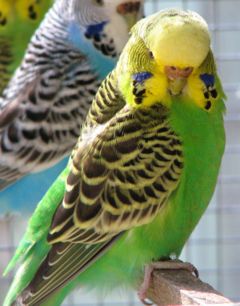
Budgerigar hen of approximately natural
colouration
|
|
Scientific classification |
| Kingdom: |
Animalia
|
| Phylum: |
Chordata
|
| Class: |
Aves
|
| Order: |
Psittaciformes
|
| Family: |
Psittacidae
|
| Subfamily: |
Psittacinae
|
| Tribe: |
Platycercini
|
| Genus: |
Melopsittacus
Gould, 1840 |
| Species: |
M. undulatus
|
|
|
Binomial name |
Melopsittacus undulatus
(Shaw,
1805) |
The Budgerigar (Melopsittacus undulatus,
nicknamed budgie), the only species in the
Australian genus Melopsittacus, is a small
parrot belonging to the tribe of the
broad-tailed parrots (Platycercini); these are sometimes
considered a subfamily (Platycercinae), which may be
correct, in which the budgerigar is then placed as a
separate tribe (Melopsittini), which is almost
certainly erroneous.
Though budgerigars are often called parakeets,
especially in
American English, this term refers to any of a number of
small parrots with long flat tails. The budgerigar is found
throughout the drier parts of
Australia and has survived in the inlands of that
continent for over 5 million years.
Etymology
At least two possible origins for the English name
budgerigar have been proposed:
- A compound of budgery, "good" and gar
"cockatoo" in some Australian Aboriginal languages.[2]
This is supported by the
Oxford English Dictionary. The word budgery
itself, also spelt boojery, was formerly in use
in
Australian English slang meaning "good".
- An alteration of
Gamilaraay gidjirrigaa (IPA:
/ɡiɟiriɡaː/)[3],
possibly influenced by the slang word budgery
mentioned above. This is supported by the
American Heritage Dictionary.
The genus name Melopsittacus comes from
Greek and means "melodius parrot". The species name
undulatus is Latin for "undulated" or "wave-patterned".
Characteristics
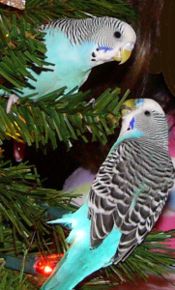
Adult females (left above) have pink to brown
ceres while adult males (right above) have blue
ceres.
Budgerigars are about 18
cm long and weigh 30-40 grams. Wild budgerigars have green underparts and rumps,
while the upperparts are barred with black and yellow. The
forehead and face is yellow in adults, and barred black with
yellow in young till they change into their adult plumage at
3-4 months of age. Each cheek has a small dark purple patch
and a series of black spots across the throat. The tail is
greenish blue or purple; outside tail feathers have a
central yellow band. Their wings have greenish-black flight
feathers and black coverts with yellow fringes. Bill olive
grey and legs greyish blue, with
zygodactyl toes.[4]
Wild budgerigars are noticeably smaller than those in
captivity. These parrots have been bred in many other
colours in captivity, such as white, blue, and even purple,
although they are mostly found in pet stores in blue, green
and seldomly white.
The colour of the
cere (the area containing the nostrils) differs between
the sexes; royal blue in males, pale-brown to white(non-breeding)
or brown (breeding) in females and pink in immatures of both
genders (usually of a more even purplish-pink colour in
young males). Young females can often be identified by a
subtle chalky whiteness that starts around the cere nostril
holes. Males that are albinos, lutinos or recessive pieds
usually retain the immature purplish-pink cere color their
entire life.
[5][4]
Colour Mutations
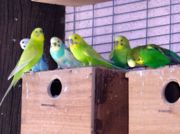
Budgerigars in an aviary
There are presently at least 32 primary mutations in the
Budgerigar Parakeet enabling hundreds of possible secondary
mutations (stable combined primary mutations) & colour
varieties (unstable combined mutations)
Of which the australian-recessive-grey-factor, the
BrownWings, the DarkWings, the english-recessive-grey-factor,
the Faded the english-recessive-grey-factor, the NSL-Ino &
the SaddleBack mutations are either highly uncommon,
extremelly rare &/or presumed 'extinct' of visual specimens.
Each of those 32 primary mutations belonging to either
one of the 4 basic groups of mutations classified in Parrot
species genetics. Namely ;
Albinism : where eumelanin is reduced in ALL body tissues
& structures deviding into 2 sub-groups ; Complete-Albinism
& Incomplete aka Partial Albinism,
Dilutism : where eumelanin is always +/- incompletely
(never completely) reduced virtually only in feathering,
Leucism : where eumelanin is reduced virtually only in
feathering and devides into 2 sub-groups ; Total-Leucism &
Local-Leucism,
Melanism : where eumelanin is +/- increased virtually
only in feathering.
Each of those 32 primary mutations inherit either ;
autosomal-Co-Dominant (A-Co-D),
autosomal-Complete-Dominant (A-C-D),
autosomal-Incomplete-Dominant (A-I-D), autosomal-recessive
(A-R), autosomal-Poly-Genic (A-P-G) Sex-Linked-recessive
(S-L)
It must be noted that : the word autosomal is often
replaced as a synonym by the NSL acronym standing for
Non-Sex-Linked.
Here's a listing of the Budgerigar aka Budgie Parakeet's
32 primary mutations genetic identities, followed by their
common names in parenthesis, followed by their according
allele &/or Locus symbols & ending with their genetic
inheritance ;
Blue Loci (plural of Locus) :
Dark-Factor : D-Locus : A-Co-D with regards to
only other Blue Loci alleles &/or always otherwise A-I-D
Blue : bl*bl : A-Co-D with regards to only other
Blue Loci alleles &/or always otherwise A-R
BlueII : blII-Locus : A-Co-D with regards to only
other Blue Loci alleles &/or always otherwise A-R
YellowFacedBlue : blII*yf : A-Co-D with regards to
only other Blue Loci alleles &/or always otherwise A-R
GoldenFacedBlue : blII*gf : A-Co-D with regards to
only other Blue Loci alleles &/or always otherwise A-R
Structural mutations :
Crest-Factor : Cr-Locus : A-P-G
Dark-Factor : D-Locus : A-I-D
Grey-Factor (Dominant-Grey-Factor) : G-Locus :
A-C-D
grey-factor (english-recessive-Grey-Factor) : g-Locus :
A-R
grey-factor (australian-recessive-Grey-Factor) : ag-Locus :
A-R
Violet-Factor : V-Locus : A-I-D
Dilutistic mutations :
dil-Locus (Dilute Locus) multiple-allelic-series :
Suffused (Dilute) : dil*dil : A-Co-D with regards
to only other dil-Locus alleles &/or always otherwise
A-R
ClearWings : dil*cw : A-Co-D with regards to only
other dil-Locus alleles &/or always otherwise A-R
GreyWings : dil*gw : A-Co-D with regards to only
other dil-Locus alleles &/or always otherwise A-R
Local-Leucistic (Pied) mutations :
ADM (Anti-DiMorphic) Pied (danish-pied, recessive-pied,
harlequin) : s-Locus : A-R
Piebald (Australian-Pied) : Pb-Locus : A-C-D
Pied (Continental_Dutch-Pied &
Clear-Flighted_Dutch-Pied) : Pi-Locus : A-C-D
Total-Leucistic (Clear) mutations :
Spangle-Factor : Sp-Locus : I-D
Dark-Eyed-Clear : dil*cw / dil*gw : is not
a genuine primary mutation but a mutation variety produced
by the visual combination of ADM-Pied & either Dutch-Pied
varieties : A-Co-D
Albinistic mutations :
NSL-Albinism (recessive-albinism) : a-Locus :
multiple-allelic-series :
NSL-Ino (recessive-Ino) : a*a : A-R
Bronze_Fallow (german_Fallow) : a*bz : A-Co-D with
regards to only other a-Locus alleles &/or always
otherwise A-R *This mutation more precisely belongs in the
Incomplete-Albinistic mutations but it was necessary to
display it's relationship with the a-Locus*
Brown or BrownWings (sepia) : b-Locus : presumed
A-Co-D with regards to only other a-Locus alleles
&/or always otherwise A-R *This mutation more precisely
belongs in the Incomplete-Albinistic mutations but it was
necessary to display it's relationship with the a-Locus*
Cinnamon (CinnamonWings) : cin-Locus : S-L-R
Dun_Fallow aka Grey-Brown_Fallow (english_Fallow) : df-Locus :
A-R
Faded : fd-Locus : A-R
possible Beige_Fallow aka Pale-Brown_Fallow
(australian_Fallow) : pf-Locus : A-R
possible Plum-Eyed_Fallow (scotish_Fallow) : pl-Locus :
A-R
SL-Albinism : ino-Locus :
multiple-allelic-series :
SL-Ino : ino-Locus : S-L-R
SL-ClearBody : ino*cl : SL-Co-D with regards to
only other ino-Locus alleles &/or always otherwise
S-L-R
Melanism :
BlackFace : bf-Locus : A-R
Other mutations :
DarkWings : dw-Locus : A-I-D
Dominant-ClearBody : Cl-Locus : A-C-D
Opaline : op-Locus : S-L-R
SaddleBack : sb-Locus : A-R
Slate : sl-Locus : S-L-R
Habitat and behaviour
Budgerigars are nomadic birds found in open habitats,
primarily in Australian
scrubland, open woodland and grassland. The birds are
normally found in small flocks, but can form very large
flocks under favourable conditions. The species is extremely
nomadic and the movement of the flocks is tied to the
availability of food and water.[4] Drought can drive flocks
into more wooded habitat or coastal areas. They feed on the
seeds of spinifex, grass weeds, and sometimes ripening
wheat.
[6][4].
Feral birds are found in the St Petersburg, Florida area in
the United States, but are much less common than they were
back in the early 1980's. Colder than normal winter
temperatures in some years and increased competition from
European Starlings are the main reasons for the
declining population.
Breeding takes generally place between June and September
in the North and between August and January in the South but
they are opportunistic breeders responding to the rains when
grass seeds become most abundant.[4]
Populations in some areas have increased as a result of
increased water availability at farms. The nest is in a hole
in a tree, fence post or even a log laying on the ground;
the 4-6 eggs are incubated for 17-19 days, with the young
fledging about 30 days after hatching.[6][4]
Both male and female budgerigars sing and can learn to
mimic sounds, although both singing and mimicry are more
pronounced in males.
Budgerigars in captivity
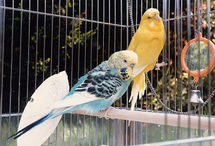
Pet budgerigars.
The budgerigar is one of the few
parrots to be domesticated as a pet. Believed to be the most
common pet parrot in the world, it has been bred in
captivity since the 1850s. Breeders have worked over the
decades to produce a wide range of colour and feather
mutations, such as yellow, blue, white, violet, olive,
albino and lutino (yellow), clearwing and spangled.
Feather mutations can produce crests or overly long shaggy
feathers known as "feather dusters".
Modern show budgerigars, also called English
budgerigars, are larger than their wild cousins, with
puffy head feathers, giving them an exaggerated look. The
eyes and beak can be almost totally obscured by feathers.
Such birds are reported to be more prone to genetic
mutations because of inbreeding. Most budgerigars in the pet
trade are not of the show variety and are similar in size
and body conformation to wild budgerigars.
Budgerigars can be taught to speak, whistle tunes, and
play with humans. They are intelligent and social animals
and enjoy the stimulation of toys and interaction with
humans as well as with other budgerigars. A common behaviour
is the chewing of material such as wood, especially for
female budgerigars.
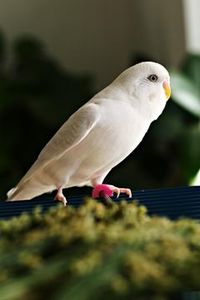
Male white budgerigar. This is not an albino
because it lacks the red eyes.
In captivity, budgerigars live an average of five to
eight years, but are reported to occasionally live to 15 if
well cared for
[7]. The life span
depends on the budgerigar's breed (show budgerigars
typically do not live as long as the common budgerigars) and
the individual bird's health, which is influenced by
exercise and diet.
Although wild budgerigars eat grass seeds almost
exclusively, avian veterinarians recommend supplementation
with foods such as fresh fruits and vegetables, sprouted
seeds, pasta, whole wheat bread and other healthy human
foods, as well as pellets formulated for small parrots.
Adding these foods provides additional nutrients and can
prevent obesity and lipomas, as can substituting millet, which is relatively
low in fat, for seeds mixes. Budgerigars do not always adapt
readily to dietary additions, however. Chocolate and avocado
are recognized as potential toxins.[8]
Plums, lemons, limes, and members of the cabbage family are
bad for them as well. Recommended fruits and vegetables are
apples, oranges, bananas, strawberries, carrots, unsprayed
lettuces, parsley, peaches and spinach.
"Context speaking" budgerigars
In 2001, budgie owner Ryan B. Reynolds of Ontario, Canada
received much publicity due to his release to the
press of certain recordings of his talking budgie, Victor.
In these recordings, Victor performed what appeared
to be "speaking in context". To the layperson, the
recordings appeared to audibly demonstrate that Victor was
able to use his 1000+ word vocabulary to express coherent
lines of thought, meaning and reasoning. Despite the
widespread TV, newspaper and radio publicity the recordings
received in 2001, the recordings have yet to be
scientifically analysed, proven, (or disproven)[9].
A budgerigar named Puck holds the world record for the
largest vocabulary of any bird, at 1,728 words.
[1]
References
[edit]
External links




